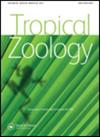Population status of the American crocodile, Crocodylus acutus (Reptilia: Crocodylidae) and the spectacled caiman, Caiman crocodilus (Reptilia: Alligatoridae) in the Costa Rican North Caribbean
IF 0.4
4区 生物学
Q4 ZOOLOGY
引用次数: 0
Abstract
Along the Costa Rican Caribbean shoreline, it is possible to find two species of crocodilians, the American crocodile (Crocodylus acutus) and the spectacled caiman (Caiman crocodilus). This region can be divided geographically into three subregions: North, Central, and South Caribbean. We conducted this research in the North Caribbean, between October 6, 2018 and August 31, 2019. Specifically, we worked in the area lying between the Jalova Station of the Tortugero National Park (TNP) and Agua Dulce Lake situated in the northern tip of Machuca Island, at the mouth of the Colorado River inside the Barra del Colorado National Wildlife Refuge (BACORE), which includes other connecting wetlands as well (Sierpe River, Samay Lake). Overall, this study area had an approximate extension of 408 km2 characterized by large, wide and deep canals, as well as wetlands, meanders, and adjacent lakes. The sampling was performed along 10 segments that varied in length from 7.5 km up to 29.49 km, located in the nearby zones of TNP and BACORE. In these zones, nightly counts were carried out using dazzling lamps. Individuals of C. acutus and C. crocodilus were classified into eight and six body size classes, respectively (both with 50 cm intervals). A relative abundance of 0.55 crocodiles and 1.37 caimans per linear kilometer was estimated during these spotlight surveys. The capture of 39 caimans let us to estimate a ratio of 30 males to 9 females (3.3:1 M:F). In stark contrast, only 1 male and 1 female crocodile were captured. A total of 85 C. acutus and 205 C. crocodilus were observed. Regarding the number of caiman sightings in the TNP, a statistically significant difference was found (Χ2=5.62, p≤0.05) for the distribution by sizes between the zones of BACORE and TNP, whereas no such difference was found for C. crocodilus sightings (Z=–1.22, p≥0.222). Some segments had a higher probability of caiman occurrence than did others in the surveys performed during the monitoring period (X2=8.36, p≤0.05), especially the Jalova-Sierpe River, Caño Negro-Tortuguero, and Tortuguero-Samay Lake (Tortuguero subarea) segments. Ninety percent of the sightings occurred in the BACORE zone, and this was significantly different (Χ2=7.34, p≤0.026) from the studied subareas. The number of crocodile sightings in the Colorado River segment was significantly different and higher than the other segments (X2=7.28, p≤0.05). There was a significant statistical difference among the sizes in all areas of study (X2=5.529, p≤0.026). The abundance of C. acutus and C. crocodilus in the north Caribbean part is lower than in the central Caribbean part of Costa Rica, where this species could use the resources available in more urbanized areas.哥斯达黎加北加勒比海美洲鳄(爬行纲:鳄鱼科)和眼镜凯门鳄(爬行纲:短吻鳄科)的种群现状
在哥斯达黎加的加勒比海海岸线上,可以找到两种鳄鱼,美洲鳄(Crocodylus acutus)和眼镜凯门鳄(caiman)。该区域在地理上可分为三个次区域:北加勒比、中加勒比和南加勒比。我们于2018年10月6日至2019年8月31日在北加勒比海进行了这项研究。具体来说,我们的工作地点位于Tortugero国家公园(TNP)的Jalova站和位于Machuca岛北端的Agua Dulce湖之间,位于Barra del Colorado国家野生动物保护区(BACORE)内的科罗拉多河入海口,该地区还包括其他连接湿地(Sierpe河,Samay湖)。总体而言,研究区面积约为408 km2,以大、宽、深的运河、湿地、曲流和湖泊为特征。采样沿10段进行,长度从7.5公里到29.49公里不等,位于TNP和BACORE附近区域。在这些地区,夜间计数是用刺眼的灯进行的。尖鳄和鳄鱼的个体分别被划分为8个和6个体型类(均以50 cm为间隔)。在这些聚光灯调查中,每线性公里估计有0.55只鳄鱼和1.37只凯门鳄的相对丰度。捕获的39只凯门鳄让我们估计出30只雄性凯门鳄比9只雌性凯门鳄(3.3:1 M:F)。与此形成鲜明对比的是,只有1只雄性和1只雌性鳄鱼被捕获。共观察到尖鳄85条,鳄鱼205条。BACORE区和TNP区凯门鳄的大小分布差异有统计学意义(Χ2=5.62, p≤0.05),而鳄鱼的大小分布差异无统计学意义(Z= -1.22, p≥0.222)。在监测期间的调查中,一些河段凯门鳄出现的概率高于其他河段(X2=8.36, p≤0.05),特别是Jalova-Sierpe河、Caño内格罗-托图格罗和托图格罗-萨梅湖(托图格罗分区)河段。90%的目击事件发生在BACORE区,这与研究分区有显著差异(Χ2=7.34, p≤0.026)。科罗拉多河河段鳄鱼目击数量差异显著,高于其他河段(X2=7.28, p≤0.05)。各研究区域的大小差异有统计学意义(X2=5.529, p≤0.026)。北加勒比地区的尖头鳄和鳄鱼的丰度低于哥斯达黎加中部加勒比地区,该物种可以利用城市化程度更高的地区的资源。
本文章由计算机程序翻译,如有差异,请以英文原文为准。
求助全文
约1分钟内获得全文
求助全文
来源期刊

Tropical Zoology
生物-动物学
CiteScore
2.50
自引率
0.00%
发文量
1
审稿时长
>12 weeks
期刊介绍:
Tropical Zoology is an international zoological journal publishing original papers in the field of systematics, biogeography, phylogeny, ecology and conservation of all terrestrial and aquatic animal Phyla from tropical and subtropical areas.
Only papers with new information, high quality and broad interest are considered. Single species description and checklists are not normally accepted. Review papers are welcome. The journal is owned by the Istituto di Ricerca sugli Ecosistemi Terrestri of the Consiglio Nazionale delle Ricerche, Florence, Italy (CNR-IRET) who performs research into the structure and functioning of aquatic and terrestrial ecosystems, focusing in particular on anthropogenic pressure and global change. The knowledge amassed forms the scientific basis for identifying the most appropriate protective and corrective interventions, and provides support for the bodies entrusted with formulating policies for environmental protection and recovery.
 求助内容:
求助内容: 应助结果提醒方式:
应助结果提醒方式:


